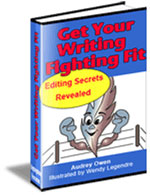[?]Subscribe To This Site
Self-Edit by Cutting Extra Calories
Logicians may reason about abstractions. But the great mass of men must have images.--Thomas Babington Macaulay
In writing, empty calories come in the form of filler words, abstractions, redundancies, and oxymorons.
Eliminate meaningless phrases.
 In speech, little conversational superfluities lighten the linguistic load for our listeners by filling time with material a listener can discount quickly, leaving the mind free to focus on meaty matters.
In speech, little conversational superfluities lighten the linguistic load for our listeners by filling time with material a listener can discount quickly, leaving the mind free to focus on meaty matters.In written text, these fillers require too much attention and cost money to put on the page.
Every editor has a hit list of these useless phrases. Here are a few of mine...
| along the lines of | future forecast |
| alongside of | hushed silence |
| as far as | in accordance with |
| as of yet | in actual fact |
| as per | in order to |
| at the present time | in terms of |
| at the time that | in the affirmative/negative |
| at this point in time | in the event that |
| by means of | in the neighborhood of |
| by reason of | on the basis of |
| center around | past history |
| close proximity | pursuant to the mandate of |
| commercial business | sufficient enough |
| due to the fact that | the area of (except mathematical meaning) |
| each and every | the fact is |
| end result | the fact that |
| eventuality | to a large extent |
| exact estimates | unbiased opinions |
| final conclusion | unexpected surprise |
| for the purpose of | with a view to |
| for the reason that | with respect to |
| free gift |
Get rid of these empty calories and all their cousins.
Make abstractions concrete.
Concrete nouns name things we access through our senses. Cinnamon, pen, and chime are concrete nouns. Concrete nouns create a clear picture for the reader.Abstract nouns are those that make no clear image in the mind. They are nouns that refer to qualities, states, or actions. Bravery, happiness, and punishment are abstract nouns.
The farther you move from the concrete in your writing, the more uncertain your communication.
Sometimes you must use abstract terms. The more academic your writing, the more likely you are to use abstractions. After all, sorting out meanings is the whole point of higher education. When you must use abstractions that your audience may find unfamiliar, make the terms understandable by giving concrete examples.
For example, if you must write about disability, which is an abstract term, define what you mean in concrete terms.
Original sentence: People with a disability will have access issues.
Rewritten sentence: People who use wheelchairs or walkers cannot reach the second floor.
Give more power to your writing by using concrete images and metaphors that stick in the mind. The next time you think of physical fitness or a good diet (abstract), I'm hoping you'll think of the text you are writing (concrete).
Eliminate redundancies.
Anything unnecessary could be said to be redundant. Here, I am referring to the tendency for some writers to say things more than once. Repeating yourself without giving new information rates somewhere between being mildly annoying to being infuriating. Trust your reader to hear you the first time.I see the lack of trust more often in fiction than in nonfiction. In fiction, the amateur writer often tells and then shows.
John was sad. He hung his head and cried. He walked with a slouch.
Or the writer shows and then tells.
John hung his head and cried. He walked with a slouch. He was sad.
Can you see the sentence that adds nothing, the one that annoys the reader? Eliminate all such redundancies in your writing.
Eliminate oxymorons.
An oxymoron is a contradiction in terms. Used intentionally, especially in poetry, an oxymoron forces new understanding. The ones you want to eliminate are the thoughtless, empty-calorie oxymorons. Cut expressions like the following.
- Pretty ugly
- Alone together
- Clearly misunderstood
- Intense apathy
- Old news
- Usually always
Cutting the empty calories from your writing reduces the load for the reader. Your text will be fit in no time.
This article is Chapter 3 of the ebook Get Your Writing Fighting Fit that teaches writers how to self-edit. Click to learn more.


